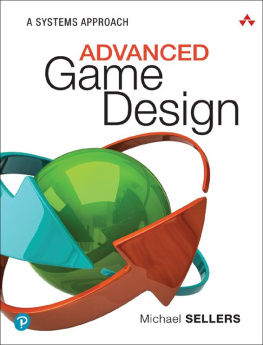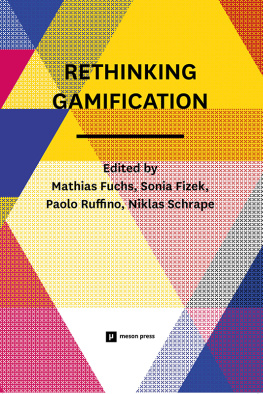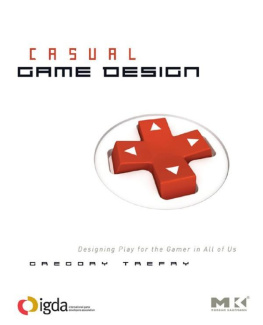Preface
Gamification may be a new term, but the idea of using game-thinking and game mechanics to solve problems and engage audiences isnt exactly new. The military has been using games and simulations for hundreds (if not thousands) of years, and the U.S. military has been a pioneer in the use of video games across branches. Three hundred years ago, Scottish philosopher David Hume laid the groundwork for understanding player motivation with his views on the primacy of the irrational self. Since the 1960s, authors have been writing books that explore the gamey side of life and psychology, while since at least the 1980s, Hollywood has been hot on the trail of gamification with movies like War Games .
And behind all this is our general love affair with games themselves. Play and games are enshrined in our cultural record, emerging with civilizations, always intertwined. We are also now coming to understand that we are hardwired to play, with researchers increasingly discovering the complex relationships between our brains, neural systems, and game play (hint: play and games help you get smarter, faster). Theres even an emerging scientific idea that games can help you live longer by staving off dementia and improving general health.
Therefore, seeing business and product designers embrace the concept of gamification should come as no surprise. As our society becomes more and more game-obsessed, much of the conventional wisdom about how to design products and market to consumers is no longer absolute. To further engage our audiences, we need to consider reward structures, positive reinforcement, and subtle feedback loops alongside mechanics like points, badges, levels, challenges, and leaderboards.
When done well, gamification helps align our interests with the intrinsic motivations of our players, amplified with the mechanics and rewards that make them come in, bring friends, and keep coming back. Only by carefully unpacking consumer emotions and desires can we design something that really sticksand only through the power of gamification can we make that experience predictable, repeatable, and financially rewarding.
We wrote this book to help demystify some of the core concepts of game design as they apply to business, written from the perspective of what a marketer, product designer, product manager, or strategist would want to know. In that regard, we are indebted to the work of notable game designers who helped clarify and amplify the process of game design, making it into a quantifiable art and science. We have leveraged their work and refined the concepts to focus on those elements that are most relevant to business. We extracted good and bad patterns from both famous and lesser-known case studies, and we tested our concepts on countless (valiant) real-world customers to arrive at the set of demonstrable, high-impact ideas presented in this book.
When used together with the Gamification Master Class (also available from OReilly, at http://oreilly.com/catalog/0636920017622) and the supplemental videos, exercises, challenges, and resources available at http://GamificationU.com, this book becomes even more powerful. You can take a concept for gamifying your product, service, or idea and bring it to fruition using the techniques we describe. Gamification by Design takes a unique approach to this exciting, fast-moving, and powerful trend, and makes it practical. We hope youll find it as useful as we enjoyed writing it.
Acknowledgments
We want to recognize the game-design writing and work of key thinkers, including Jesse Schells The Art of Game Design: A Book of Lenses (Morgan Kaufmann), Jon Radoffs Game On (Wiley), and Ralph Kosters A Theory of Fun for Game Design (Paraglyph Press). We are also lucky to have been able to access and distill the insights of Sebastian Deterding, Susan Bonds, Jane McGonigal, Amy Jo Kim, Ian Bogost, Nick Fortugno, Nicole Lazzaro, Rajat Paharia, Kris Duggan, Keith Smith, and Tim Chang. And a special thanks to the folks at Badgeville who sponsored , providing insight into their groundbreaking product, as well as practical coding and design tips that can be used in any implementation.
Wed also like to recognize the efforts of Jeff Lopez, Danyell Thillet, and Joselin Linder, who each contributed in their own way by helping us research, refine, and produce this work. And, of course, to the OReilly Media team, including Mary Treseler, Sara Peyton, Kirk Walter, Keith (Steve) Thompson, and Betsy Waliszewski.
Gabe would like to thank his mother, father, (not-evil) stepdad, sister, and brother (why say in-law?), without whose support none of this would have been possible. Also, thanks to Veronica Cseke and the Fraizingers (Mary, Izzy, Rochelle, Shoshanna, and Elliot)proof that family need not always be related by blood. And extra special thanks to Jason Evege, one of the most driven and inspirational people hes ever met.
Christopher would like to thank his family, especially his mother and father, for their limitless patience and encouragement of a child who would never stop asking questionsand then debating the answers. And special thanks to Pablo Lpez Yez, for always supporting and encouraging an adult who hasnt changed all that much.
New York City, 2011
Introduction
Summer. At dusk, children run between trees and fireflies, shouting through laughter and squealing, Youre it!
Math class is ending. A cheer erupts as the teacher tells her students to put their books away. She splits the class into teams. In twos, they approach the chalkboard and face off for the love of numbers and grade-school honor.
Its Saturday night. A roomful of suburban mothers are playing Mahjong. As the tiles click and scores get recorded, they laugh, complain, and bond.
It is no wonder that the simple idea of a game can induce some of lifes strongest and most satisfying memories. After childhood, games were relegated to the fringes of our livesthe downtime, the fun between the drudgery of work, the opposite of real life.
But the tides are turning. Games have begun to influence our lives every day. They affect everything from how we vacation to how we train for marathons, learn a new language, and manage our finances. What we once called play at the periphery of our lives is quickly becoming the way we interact. Games are the future of work, fun is the new responsible, and the movement that is leading the way is gamification.


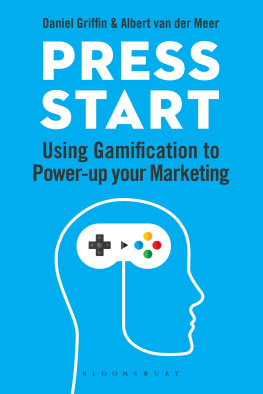
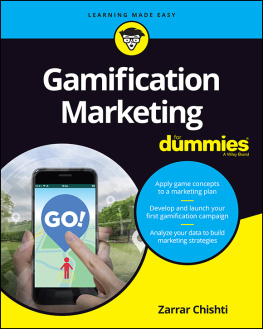


![Keith Burgun [Keith Burgun] - Clockwork Game Design](/uploads/posts/book/119426/thumbs/keith-burgun-keith-burgun-clockwork-game-design.jpg)
![Ethan Ham [Ethan Ham] - Tabletop Game Design for Video Game Designers](/uploads/posts/book/119417/thumbs/ethan-ham-ethan-ham-tabletop-game-design-for.jpg)
